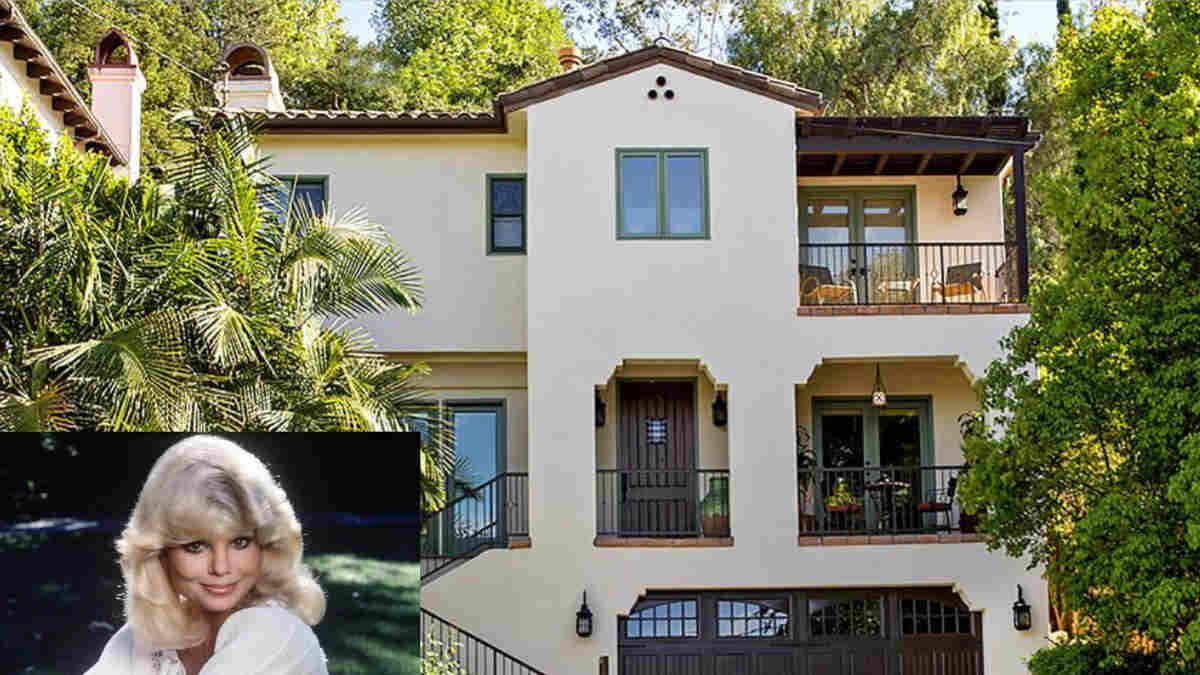For anyone who came of age with a TV set in the living room during the late ’70s or early ’80s, Loni Anderson wasn’t just a star — she was the bombshell of primetime. With her platinum-blonde hair, razor-sharp comedic timing, and unforgettable role as Jennifer Marlowe on WKRP in Cincinnati, she embodied an era where television felt both bigger and more intimate. But here’s the twist most people don’t expect: while many of her contemporaries faded from both view and value, Loni’s story didn’t stop when the cameras did.
Today, in a world that churns through fame at viral speed and spits out even A-listers by Friday, Loni Anderson stands as a surprisingly grounded example of how to turn celebrity into sustainability. From smart real estate investments to a residual income stream that hasn’t dried up with age, what Loni still owns isn’t just wealth — it’s strategy.
This isn’t another shallow net worth piece or a glamorized trip down memory lane. Instead, we’re pulling back the curtain on how one of TV’s most iconic faces translated stardom into long-term financial security — and what that says about power, planning, and longevity in Hollywood. From property deeds to royalty checks, Loni’s legacy offers more than nostalgia — it offers a masterclass in owning your future.
From Primetime to Property Lines — How Loni’s Wealth Outlasted the Spotlight
The Paychecks That Built a Portfolio
When WKRP in Cincinnati debuted in 1978, Loni Anderson quickly became one of television’s most recognizable faces — and, for a while, one of its better-paid women. Reports from the era suggest she earned around $20,000 per episode at the show’s peak — a respectable figure, though still significantly lower than many of her male counterparts on similarly rated shows. At roughly 22 episodes a season, that translated into nearly half a million dollars a year — before endorsements, guest spots, or magazine features.
But what truly set Loni up long-term wasn’t just the paycheck — it was syndication. WKRP gained cult status in reruns, meaning residuals continued to trickle in long after the spotlight dimmed. In an era before streaming, syndication was one of the only real vehicles for passive income in TV. While not “set for life” money by today’s standards, for a woman navigating 1980s Hollywood, it was the kind of steady success that opened doors — and investment opportunities.
Smart Moves in a Risky Industry
Hollywood is no stranger to cautionary tales — actors who rose fast, lived lavishly, and left little behind. Loni Anderson took a different path. While she never flaunted wealth in the tabloid sense, she quietly made choices that suggested a long view. Real estate, not luxury cars or vanity ventures, became her preferred asset class. Friends and industry insiders have hinted at her instinct for stability — buying property in undervalued neighborhoods and holding onto assets as they appreciated.
Whether she acted on sound advice or sharp intuition (likely both), Loni sidestepped the financial instability that swallowed many of her peers. She didn’t chase every role or cash grab, and that restraint may have been her smartest move of all. In the uncertainty of a business that rarely plans for the long term, Loni began building a foundation that would matter far more than headlines — one brick, and one wise decision, at a time.
California Dreamin’ — Inside the Homes Loni Anderson Has Owned and Kept
The Sherman Oaks Estate That Still Bears Her Name
Tucked behind tall hedges on a quiet, sun-drenched street in Sherman Oaks, Loni Anderson’s longtime estate feels more like a sanctuary than a celebrity statement. Spanning just over 4,600 square feet on nearly half an acre, the property blends classic California ranch charm with subtle mid-century elegance. Think wide hallways, oversized windows, and a pool so inviting it looks like a still from a 1980s magazine spread — except it’s real, and it’s hers.
Sherman Oaks isn’t Beverly Hills, and that’s exactly the point. It’s a neighborhood known for its privacy, its well-heeled (but low-key) residents, and its proximity to the studios without the noise of Hollywood proper. Over the years, neighbors have included sitcom stars, respected character actors, and the occasional indie filmmaker — the kind of company Loni’s career trajectory mirrors: enduring, respected, deliberately off the tabloid radar.
Why has she held onto this particular property? Maybe because in an industry known for constant reinvention, this house offered something rarer — continuity. Real estate records suggest it’s been in her name for decades, weathering market booms and busts. For Loni, this wasn’t just a house. It was an anchor — a tangible reminder that while roles come and go, roots can hold fast.
Past Holdings, Present Value
While Loni Anderson’s Sherman Oaks estate may be her signature hold, it’s far from the only stop on her real estate journey. Over the years, she owned several Southern California properties — each one reflecting a different era of her career, and a different phase in her approach to wealth. One early home in Encino, purchased in the 1980s for a reported $430,000, was later sold in the mid-1990s — just before the area experienced a dramatic post-recession boom. Today, that same property is estimated to be worth over $2 million.
She also briefly owned a Mediterranean-style villa in the Hollywood Hills, a property that once overlooked the city’s sprawl and seemed tailored for someone at the peak of their fame. But Loni never lingered in homes just for status — she moved with strategy. That villa was sold after a few years, reportedly for a modest gain, before prices skyrocketed in the early 2000s.
These transactions don’t read like speculative flips or rash decisions. Instead, they suggest a measured, almost intuitive rhythm: buy solid, stay long enough to cycle, exit before the tide turns. In an industry where extravagance often eclipses foresight, Loni’s property history tells a quieter, smarter story — one of patience, timing, and knowing when to let go.
The Royalty Rundown — What Keeps the Checks Coming In
Still Airing Somewhere — The Long Tail of Syndicated TV
Long before streaming reshaped the way we consume media, syndication was the golden goose of television — and for stars like Loni Anderson, it still pays. WKRP in Cincinnati only ran for four seasons, but it struck syndication gold in the ‘80s and ‘90s, airing in rerun blocks across local stations nationwide. That meant one important thing: residuals.
Under SAG-AFTRA rules, actors earn a percentage of their original pay each time an episode re-airs, though that amount diminishes over time. In the early days, those rerun checks could rival a month’s salary. Even today, modest royalty income can trickle in from obscure late-night cable runs or digital licensing abroad.
The key difference back then? Contracts often included long-term syndication clauses — unlike some modern streaming deals, which are flatter and less actor-friendly. So even decades later, while the checks might not be mansion-worthy, they’re steady. And for someone like Loni, who balanced her brand with smart financial planning, those residuals became part of a larger strategy: build wealth once, then let it work for you — quietly, consistently, and with surprising longevity.
Audio, Ads, and Appearances — Secondary Income Channels
While syndication royalties may be the backbone of Loni Anderson’s passive income, her financial savvy likely extended into less obvious — but equally smart — channels. One often-overlooked stream for veteran actors? Voice work and narration. Though not heavily publicized, Anderson has lent her voice to animated series and promotional content over the years — an avenue that allows stars to stay active without stepping back into the spotlight.
Then there’s the power of nostalgia marketing. As retro culture surges, brands have increasingly tapped iconic figures from the ‘70s and ‘80s for ad campaigns targeting Gen X and Boomer audiences. Though not a fixture in commercials, Loni’s image has appeared in anniversary retrospectives, syndicated promo spots, and legacy media tie-ins — all of which could involve licensing fees or royalties.
Finally, appearances at fan conventions, tribute specials, and even memoir-related press can add subtle income while reinforcing her brand. In today’s fragmented media landscape, relevance isn’t always about trending — it’s about lasting. And Anderson, with her iconic presence and careful discretion, continues to profit from being a name people still remember — and trust.
How Loni’s Holdings Compare to Her TV Contemporaries
Loni Anderson wasn’t the only blonde bombshell commanding primetime in the late ‘70s and ‘80s — but she may be one of the few from that era whose financial foundation still stands strong. Take Linda Evans, for instance, whose opulent Dynasty role made her a household name. Evans famously poured much of her wealth into a secluded Washington state retreat and later a wellness-oriented lifestyle. While she eventually downsized, she’s spoken openly about the challenges of maintaining high-end real estate post-fame.
Then there’s Farrah Fawcett, whose iconic poster and Charlie’s Angels fame brought fortune and relentless public scrutiny. After her passing in 2009, Farrah’s estate was valued at roughly $5–6 million — much of it in art and property, including a Brentwood condo she had owned for decades. Her estate planning was methodical, with a trust that included a bequest to the University of Texas — but it also reflected the costs of fame, illness, and legal complexities.
In contrast, Loni’s approach appears more low-profile but quietly enduring. She’s avoided overextending herself in flashy purchases or sprawling estates, favoring real estate with long-term upside and a lifestyle that mirrors sustainability over spectacle.
What emerges isn’t a comparison of wealth, but of strategy. While some of her peers were swept up in the whirlwind of celebrity spending or legacy maintenance, Loni chose a path defined by control, caution, and continuity — a subtle but telling difference that has allowed her holdings to age as gracefully as she has.
What She Didn’t Keep — Missed Deals and Market Shifts
No matter how carefully one plays the game, even the savviest stars miss a few moves — and Loni Anderson is no exception. While much of her real estate portfolio reflects smart timing and sensible investment, there were moments when choices, in hindsight, left value on the table.

In the mid-1990s, Loni reportedly sold a contemporary hillside property in Studio City just before the neighborhood’s tech-adjacent boom began. What had been a solid six-figure sale at the time might now be worth three to four times more, thanks to the area’s sharp climb in value among entertainment and startup professionals. Still, it’s unclear whether she sold out of necessity or simply by preference — not all decisions are purely financial.
And then there’s the acting side. Loni was once considered for roles in major sitcoms and dramas post-WKRP, including a rumored near-casting in Dynasty or Cheers. Whether she passed or was passed over, the result was the same: she didn’t ride a second television wave as many of her peers did. But that may have been by design.
Rather than chasing roles or windfalls, Loni seemed to prioritize stability over speculation. These “missed” opportunities weren’t failures — they were trade-offs. And if anything, they show a woman who understood that sometimes, letting go can be just as strategic as holding on.
What Loni Taught Me About Owning Your Legacy
I’ve never met Loni Anderson. But after spending weeks digging through archives, watching old interviews, and tracing the arc of her career, I feel like I’ve come to understand something deeper than the blonde bombshell image most people remember.
What struck me wasn’t just her ability to navigate fame — it was how quietly, almost deliberately, she seemed to step away from it when it no longer served her. In an industry that often chews up women after 40, Loni didn’t cling. She evolved. And that, in its way, is revolutionary.
She didn’t build an empire in the flashy, modern sense. There were no billion-dollar makeup lines or headline-making production companies. But she built something more rare: a sustainable identity. She owned homes, not hype. She chose roles with care. And when the cameras stopped rolling, she let her portfolio — not publicity — do the talking.
As someone who writes about legacy for a living, I often think about how we define success. Loni reminded me that legacy isn’t always loud. It doesn’t need constant reinvention or validation. Sometimes, it’s about consistency, smart choices, and knowing when to pivot.
Loni Anderson taught me that in a world obsessed with relevance, real power lies in quiet ownership — of your image, your finances, and your future. That kind of legacy isn’t built overnight. But when it’s done right, it lasts a lifetime — and beyond.
Loni Anderson Today — A Life of Quiet Ownership and Strategic Presence
These days, Loni Anderson lives largely outside the noise of Hollywood — not hidden, but distinctly intentional in how she shows up. Still residing in her longtime Sherman Oaks home, she’s chosen consistency over spectacle, trading red carpets for quiet rooms filled with family photos, art, and the soft rhythm of a life well-curated.
Now in her late 70s, Loni makes rare but meaningful public appearances. Whether it’s speaking about lung health (a cause close to her heart after her parents’ struggles) or attending industry tributes, she shows up with grace — a reminder that presence doesn’t have to be constant to be impactful. She’s also been a vocal advocate for Alzheimer’s awareness, particularly after her beloved partner’s diagnosis, blending personal experience with public responsibility in a way that feels grounded and sincere.
Financially, she remains steady — not extravagant, but secure. Her income sources, from real estate to residuals, still flow, even if quietly. What’s most compelling, though, is how much she seems to own her narrative. In an industry that often defines women by age or era, Loni appears to have sidestepped those traps. She’s not clinging to the past, nor chasing reinvention.
She’s simply living — wisely, privately, and with the kind of confidence that comes from knowing she played the long game and won. Loni Anderson today isn’t just the echo of a career — she’s the embodiment of what it means to own your choices and their rewards.
The Art of Longevity in Hollywood’s Fast Lane
In a business built on spotlight and short shelf lives, Loni Anderson’s story is a rare study in endurance — not just in fame, but in foresight. She didn’t explode onto the scene and burn out like so many of her peers. Instead, she carved a quieter, more lasting path: investing wisely, choosing carefully, and never allowing public perception to dictate her next move.
Her legacy isn’t built on scandals or reinvention, but on stability — a word rarely associated with Hollywood. Loni reminds us that success doesn’t always shout. Sometimes, it looks like a house you never had to sell, a residual check that still arrives, a name that’s remembered with respect.
In a culture that celebrates hustle and reinvention, her example offers a different — and deeply valuable — kind of blueprint: one rooted in ownership, intention, and longevity.
Loni Anderson didn’t just make it big — she made it last. And that might be the most powerful move a star can make.
Mohit Wagh is the co-founder of The Graval with over 10 years of experience in SEO and content strategy. He specializes in crafting data-driven, authoritative content that blends cultural insight with digital growth.





4 thoughts on “Inside Loni Anderson’s Real Estate and Royalties: What She Still Owns Today”